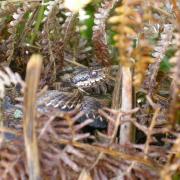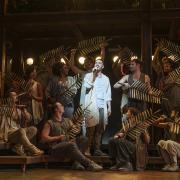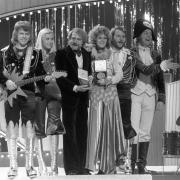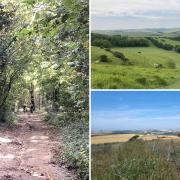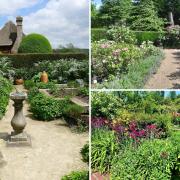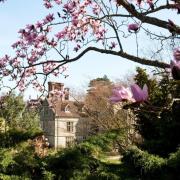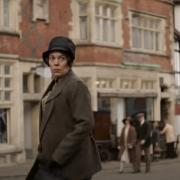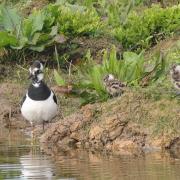Solution for the “A time to stand and stare” piece by Tony Ward in the Sussex Life August issue
Where is it? A time to stand and stare
Oxbow lakes and languid loops,
a channel to the sea,
the suck of surf on shingle beach,
the chalk cliffs standing by.
.
Sheep on the hillside, cattle in the meadow,
tracks in the margins, burrows by the hedgerow,
heron, cormorant, egret, gull,
frogs and newts and toads.
.
Cottages, Cable Hut, Beggars Barn,
village abandoned, horse reborn.
.
Vikings, raiders, pirates,
Napoleon deterred.
A threat twice more, twice more at war,
barracks, trenches, tank traps.
The silent river mined.
.
Three hundred years, three hundred men,
heroes and villains, a smugglers’ den,
Five and twenty ponies
Trotting through the dark –
Brandy for the Parson,
‘Baccy for the Clerk.
.
And if you wake at midnight, and hear a horses feet,
hear the cut and thrust of cutlass,
hear echoes from the guns,
be careful what you say my dear, be careful whom you meet.
Solution – Cuckmere Haven and the Alfriston smugglers.
Explanation of embedded clues
The title is taken from the poem, ‘Leisure’, by William Henry Davies (1871-1940), a reclusive Welsh-born poet, whose lyrical poems about nature won him widespread popularity in his day. Nowadays, the poems tend to be better known than the poet:
What is this life if, full of care,
We have no time to stand and stare...
Cuckmere Haven is a text-book example of ‘a river in old age’. Eric Ravilious, the war artist, a major collection of whose work is displayed in the Towner, Eastbourne, captured the scene brilliantly in his watercolour, ‘Cuckmere Haven’. The meanders, “Oxbow lakes and languid loops” are the result of the water-flow slowing down and depositing silt as it finds its way across a flood plain to the sea. ‘Meander’ (Maiaondros) was a river god in Greek mythology. He was the patron deity of the winding Buyuk Menderes River in what was then Phrygia in the ancient region of Anatolia (modern south-western Turkey). His name is now universally applied to this feature on any river.
Looking down upon Cuckmere Haven one could be forgiven for believing that this is indeed the work of a river god.
The “channel to the sea” refers to the straight ‘Cut’ put in the river in 1847 to improve drainage, prevent flooding and provide a more practical passage for barges. For some hundred years before that however, small barges had been able to navigate the river to just above Alfriston. The last barge to make her journey up river, in 1915, was the Iona, bringing her usual cargo of beach and chalk from Seaford. A less welcome visitor, on 27 October 1943, was a mine which floated up on the incoming tide. The village had to be evacuated while a naval bomb disposal team defused it. The danger over, the village decided to make a feature of it. It is now to be found on the Tye.
Verse 2 relates to both the farmed animals and the wildlife. At the Seven Sisters Country Park countryside centre at Exceat the life of the shepherds is remembered in an original ‘shepherd’s caravan’. This was the shepherd’s ‘mobile home’ in which he lived and from which he worked out on the hillsides during the lambing season. A National Trust leaflet records the fact that sheep have been grazed on the Downs for thousands of years, and that Alfriston is believed to be the last recorded place where a shepherd was buried with a lock of sheep’s wool in his hand to show St. Peter why he was excused from attending church.
The “tracks in the margins” refer to the bird tracks in the silt at the river edges. There is also a large population of rabbits, and the “frogs and newts and toads” keep the locals busy in their breeding season. They venture out from the drainage ditches onto the Litlington Road and have to be rescued to save them from being run over. Luckily for them it is not too busy a road.
We then turn to man-made features.
The Coastguard Cottages were built at the time of the founding of the National Coastguard Service in 1822. Up until then the Customs & Excise Men had no permanent base from which to call out Naval and land-based units of soldiers to try to control the smuggling gangs. Another spur had been the recent threat from invasion during the Napoleonic Wars. The threat to the Cottages now is from coastal erosion, hence the Cuckmere Haven ‘Save Our Shore’ campaign.
The Cable Hut dates back to the year 1900. It was one of a number of cable stations around the south coast for undersea telegraph lines to France. The Cuckmere station served cables running to Le Havre and Cap d’Antifer. For security reasons, during World War II the lines were cut and the Hut converted to a pill-box. Since then it has had a chequered history – a store for fishing and boating gear and as a family beach hut.
Beggars Barn (now known as South Hill Barn) was an important signalling point for smugglers, being on a high point to the west, overlooking the river mouth.
The “village abandoned” was Exceat. Exceat village itself is no more, but in its heyday it was an important settlement. During the twelth century Exceat paid more in taxes than did Lewes. Possibly founded in Saxon times, under Alfred the Great in the ninth century Exceat may have been the site of one of his naval bases in his war with the Vikings. A naval connection quite probably continued into the reign of King Edward I at the turn of the 14th century. There was no one reason for the village’s abandonment. It experienced a succession of disasters. These included poor harvests, the Black Death, and raids by French pirates. The remaining villagers upped sticks and left in the mid 1400’s. However there does remain one tangible memorial, thanks to the Rev G W A Lawrence, Rector of West Dean and the Sussex Archaeological Society. This is a stone inscribed, ‘Here formerly stood the parish church of Excete built probably in the XIth century and abandoned in the XVth century, the parish being incorporated with West Dean’.
But a “horse reborn”? No, this is not an equine phoenix, but to the inhabitants of Litlington, equally magical. The Litlington White Horse (or Cuckmere White Horse) is a case of ‘new for old’. Both horses were cut into the east-facing slope near the top of Hindover Hill (‘High and Over’). The first horse was thought to have been cut in 1836 or 1838, the latter date being the year of Queen Victoria’s coronation. It was said to be the initiative of the son, James Pagden, of the tenant farmer of Frog Firle Farm together with his brothers and cousin. Another version of its origin ascribes it to two youths in 1860, who seeing a patch of bare chalk resembling a horse’s head, decided to add a body. Whatever the truth, its arrival was a mystery. This first horse galloped off into the undergrowth in the 1920’s.
A few years later, three men decided to play a prank on the villagers of Litlington. John Ade, Eric Hobbis and Mr. Bovis took advantage of a full moon to secretly re-cut a new White Horse overnight near to the site of the original. Upon drawing back their curtains the next morning the inhabitants were startled to see that their missing White horse had returned, as if by magic. Apart from the need to camouflage such an obvious landmark during the second World War, this time she is here to stay. Both The White Horse and Frog Firle Farm have been acquired by The National Trust. The horse is ‘scoured’ when necessary to maintain its visibility. Frog Firle Farm is now a National Trust Education Centre.
Verse four recounts the Cuckmere Haven’s wartime transformation. The threat in Napoleonic times has already been mentioned. But now “A threat once more, twice more at war” refers of course to the two World Wars of the twentieth century. Unfortunately, the Haven presents a tempting landing site for invaders. This has been the case since the time of the Vikings.
The first barracks had been established on either side of the estuary around the year 1800. This was partly in response to a possible French invasion and partly to curb the activities of the smugglers, who were costing the government a significant amount in lost taxes. Once the ‘Coast Blockade Service’ was formed, followed by a permanent presence in the Coastguard Cottages, the barracks were dismantled. Hutted camps were to return though with the outbreak of the First World War. There was also a rifle range and ‘training trenches’.
The threat passed, at least until the outbreak of the Second World War. With advances in the technology of warfare, more extensive defences were needed. “Tank traps” lined the beach, ditches fronted by concrete ‘dragons’ teeth’ backed up with anti-tank scaffolding, machine guns in pillboxes, minefields and barbed wire. The downs on either side were ‘trenched’ to prevent enemy aircraft landing and even “The silent river mined”. The Cuckmere Valley was a specific target for ‘Operation Sea Lion’, the German invasion plan. The Luftwaffe had extensively reconnoitred the area. Even when ‘Sea Lion‘ was abandoned after the Battle of Britain, the Cuckmere was still the focus of enemy raids by sea and air. There was even a plan to set up a lighting decoy in Cuckmere Haven that replicated the lights of Newhaven, with the intention of diverting bombers from the port. It was also at the western edge of the corridor through which V1 flying bombs passed en route to London. On both counts though, Cuckmere Haven escaped being bombed.
But stepping back in time, what about those smugglers?
“Three hundred years, three hundred men” refers both to the length of time over which smuggling grew into a big business, and to a specific incident in September 1783. A newspaper of the time reported that it was quite common to see a dozen smuggling vessels lying off the coast in broad daylight. To the local population they were ‘free traders’ - “heroes and villains”. In connection with Robert Louis Stevenson’s novel Kidnapped, the attitude at the time was explained as follows, ‘The thievery was boasted about and romanticised until it became a kind of heroism. It did not have any taint of criminality and the whole of the south coast had pockets vying with one another over whose smugglers were the darkest or most daring.’ The 1783 incident, from a letter, dated Sept 18th 1783, reflects the way in which such enterprises were viewed:
On Tuesday evening, between two and three hundred smugglers on horseback came to Cookmere and in defiance of the King’s officers, they went their way in great triumph. About a week before this, upwards of three hundred attended at the same place; and though the sea ran mountains high, the daring men in the cutters made good the landing ...
The smugglers moreover did not necessarily have to resort to force against the King’s officers. There were also suspicions of attempted bribery, ‘(the smuggler) John Clare put on a lump of chalk £20 and pointing to it said there should be twenty pounds for me and a cart in readiness to carry me to what part of the country I pleased ...’
The “smugglers’ den” is The Smuggler’s Inn in Alfriston, then known as The Market Cross Inn. Its present name would have been a bit of a giveaway! This was the headquarters of Stanton Collins’ gang. No doubt it was chosen for its layout, which would have given the smugglers plenty of time to escape unwelcome callers. The house had 21 rooms, a maze of passages, six staircases, at least 47 doors and underground passageways leading to adjoining buildings. The co-operation of the people of Alfriston was such that they successfully eluded the law, primarily through lack of hard evidence, for many years. Eventually though the gang broke up when Collins was transported, not for smuggling, but for barn burning and stealing sheep.
The remainder of verse 5 is taken directly from Rudyard Kipling’s well-known poem ‘A Smuggler’s Song’, as is the opening line of the last verse. A complete copy of his poem is featured on one of the display boards in the National Trust’s Birling Gap visitor centre.
Acknowledgement of sources
• National Trust leaflet, Welcome to the Cuckmere Valley
• James Russell, Ravilious in Pictures: Sussex and the Downs, The Mainstone Press, 2009 (pp. 32-33, ‘Cuckmere Haven’)
• Daniel Karlin (Ed.), Rudyard Kipling Stories and Poems, Oxford World’s Classics, 2015 (pp. 493-494, ‘A Smuggler’s Song’)
• Roger McGough (Foreword), Poetry Please, Faber and Faber, 2013 (pp. 67-68, ‘Leisure’, William Henry Davies).
• www.sevensisters.org.uk/page38.html
• www.nationaltrust.org.uk/cuckmere-valley
• en.wikipedia.org/wiki/Cuckmere_Haven
• en.wikipedia.org/wiki/River_Cuckmere
• www.sussex.ac.uk/geography/researchprojects/coastview/Rendels_postcards/cuckmere.htm
• Relevant websites found by searches for ‘Cuckmere Haven’, ‘Cuckmere River’, ‘East Sussex Smugglers’, ‘WW2 Defences at Cuckmere Haven’, ‘Poems about smugglers’, ‘The Smugglers Inn Alfriston’, ‘The White Horse figure Cuckmere’, ‘Exceat’, ‘Iona Cuckmere River barge’.



